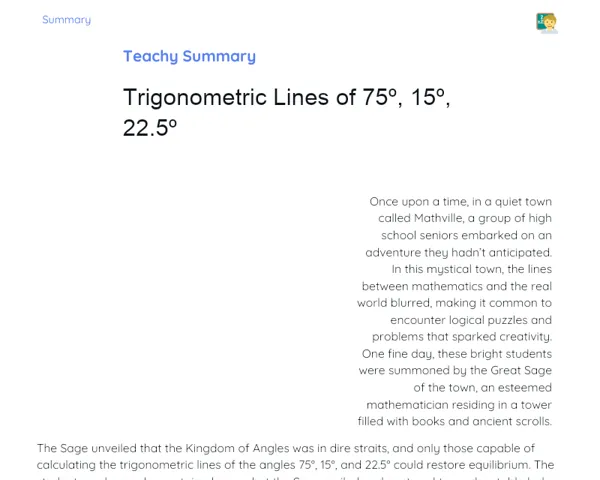Summary Tradisional | Algorithms and Problems
Contextualization
In today's lesson, we delved into two key concepts in mathematics: even and odd numbers, and the ways we can recognise them using algorithms and flowcharts. Even numbers are those that can be evenly divided by 2 without leaving a remainder, while odd numbers yield a remainder of 1 when divided by 2. This understanding is crucial for tackling various maths problems, and it has practical applications in everyday life, such as sharing items fairly among people or organising events in a balanced manner.
We also introduced algorithms, which are step-by-step methods for solving problems, along with flowcharts, which visually represent these steps. These tools are immensely helpful not only in maths but also in areas like computer programming and project management. When we grasp algorithms and flowcharts, we can approach problems in a structured way, making it easier to visualise and implement the steps needed to find a solution.
To Remember!
Understanding Even and Odd Numbers
Even numbers can be divided by 2 without any remainder, whereas odd numbers leave a remainder of 1 when divided by 2. This concept is foundational in mathematics and comes in handy in various scenarios. For instance, when arranging items in pairs, we can easily identify if we have an even or odd total. If a number can be split into two equal groups, it’s even; if not, it’s odd. Knowing how to identify even and odd numbers is vital not just for solving maths problems but also for practical tasks, like distributing goods fairly among a group. Furthermore, recognising these numbers is a stepping stone toward more advanced mathematical skills, including factoring and solving equations.
-
Even numbers can be split evenly into two groups.
-
Odd numbers leave a remainder of 1 when split by 2.
-
Being able to identify even and odd numbers is useful in daily situations.
Mental Math for Spotting Even and Odd Numbers
A swift and effective technique to figure out if a number is even or odd is by using mental maths. Simply check the last digit of the number. If the last digit is 0, 2, 4, 6 or 8, then the number is even. Conversely, if the last digit is 1, 3, 5, 7 or 9, the number is odd. This method proves particularly handy when working with large numbers, where direct division might be a hassle. Regular practice enhances mental agility and sharpens problem-solving skills. This technique is often applied in maths tests and competitions, where both speed and accuracy are essential.
-
Look at the last digit of the number to find out if it's even or odd.
-
Last digits of 0, 2, 4, 6, and 8 signal even numbers.
-
Last digits of 1, 3, 5, 7, and 9 indicate odd numbers.
Introduction to Algorithms
Algorithms are defined sequences of steps designed to solve specific problems. In mathematics, they help in tasks like identifying even and odd numbers. For example, a straightforward algorithm for determining if a number is even or odd would involve dividing the number by 2 and checking the remainder. If the remainder is 0, the number is even; if not, it is odd. Mastering algorithms is an essential skill not just in mathematics but also in other fields such as computer programming and engineering. By using algorithms, we can craft efficient and repeatable solutions for a variety of challenges.
-
Algorithms are structured sequences of steps to tackle problems.
-
To identify even and odd numbers, an algorithm involves division by 2 and checking the remainder.
-
Algorithms are applicable in numerous fields, including programming and engineering.
Creating Flowcharts
Flowcharts are graphical representations of algorithms, allowing for the visualisation of the steps taken to solve a problem. They utilise shapes like rectangles for processes and diamonds for decision points to illustrate each phase of the algorithm. For instance, a flowchart for identifying even and odd numbers would begin with inputting the number, followed by dividing it by 2, then making a decision based on the remainder. If the remainder is 0, the number is even; if not, it is odd. Flowcharts serve as effective tools for organising thought processes and clearly communicating complex procedures. They're commonly employed in fields such as engineering, project management, and computer science.
-
Flowcharts visually depict algorithms.
-
They use shapes like rectangles (process steps) and diamonds (decision-making) to outline steps.
-
Flowcharts make it easier to visualise and communicate intricate processes.
Key Terms
-
Even Numbers: Numbers that can be divided evenly by 2 without a remainder.
-
Odd Numbers: Numbers that yield a remainder of 1 when divided by 2.
-
Mental Calculations: A method for identifying even and odd numbers by checking the last digit.
-
Algorithms: Defined processes composed of steps to address problems.
-
Flowcharts: Visual representations of algorithms using shapes.
Important Conclusions
In today's lesson, we examined the concepts of even and odd numbers, learning how to identify them through mental calculations and algorithms. We recognised that even numbers can be divided evenly by 2, while odd numbers leave a remainder of 1. This skill is crucial not only for resolving maths-related questions but also for real-world scenarios.
We also touched on algorithms, which are structured sets of steps for addressing specific issues. We applied a basic example of an algorithm for identifying even and odd numbers, underscoring the importance of this tool in both mathematics and other sectors like programming and engineering. The class also learned how to represent these algorithms graphically via flowcharts, which aids in the visual interpretation and communication of processes.
The relevance of these topics is highlighted by their practical uses and their contribution to enhancing students' logical reasoning. By grasping and applying algorithms and flowcharts, students can approach problem-solving in a systematic and effective manner. We encourage them to continue exploring these concepts to further develop their mathematical skills and apply them in diverse everyday and academic contexts.
Study Tips
-
Practice daily identifying even and odd numbers, using mental maths to sharpen both agility and accuracy.
-
Design and solve problems employing algorithms and flowcharts to strengthen your grasp of these concepts.
-
Look into supplementary resources, like books and online educational videos, about algorithms and flowcharts to expand your knowledge and uncover new applications.



